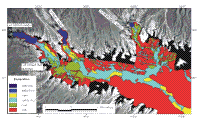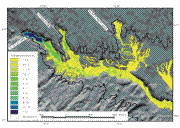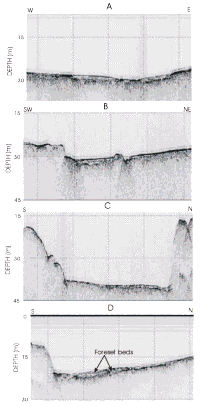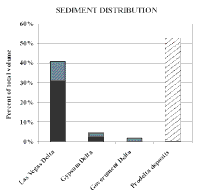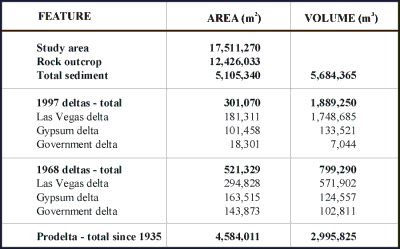Surficial Geology and Distribution of Post-Impoundment Sediment in Las Vegas Bay, Lake Mead
Discussion
Part I
We mapped the distribution of post-impoundment sediment in Las Vegas Bay using sidescan sonar imagery and seismic-reflection profiles. The sidescan-sonar imagery, and its continuous coverage of the lake floor, provides the detailed areal distribution of sediment. Differences in backscatter intensity of the sidescan imagery show differences in the surficial geology of the deposit and different processes of deposition. The seismic profiles measure the thickness of the deposit and reveal its internal structure. The integration of the imagery with the profile data allows a thorough mapping of the sediment in the shallow part of the lake.
Click on each figure for larger image with caption
Table 1. Summary of areal extend and sediment volume associated with different parts of the post-impoundment deposit
Post-impoundment sediment is only found covering the floors of former stream beds, and covers roughly one third of the study area in Las Vegas Bay (Table 1). The remainder of the floor of the Bay is rock outcrop that is still exposed on the divides between the stream beds
(Fig. 4). The post-impoundment sediment covers slightly over 5 x 106 m2 having a volume of slightly under 5.7 x 106 m3 (Table 1). In general the post-impoundment sediment is thickest and coarsest grained nearshore, in the deltas at the mouths of the three washes, and thins and becomes finer grained beyond the deltas in the
deeper parts of Las Vegas Bay (Fig. 4 and Fig. 6).
The delta deposits at the mouths of Las Vegas, Gypsum, and Government Washes show that these three ephemeral streams are the primary source of sediment that has been supplied to Las Vegas Bay since impoundment. There are wide expanses of rock outcrop between most of the shoreline around Las Vegas Bay and the area covered by sediment (Fig. 4). If sediment were entering the bay from other point sources, the rock outcrops near those source areas would be buried by sediment. If eolian sediment were a major source to Las Vegas Bay, a blanket of sediment should drape the lake floor uniformly.
The seismic profiles do not show a sediment drape on the valley walls (Fig. 5 and Fig. 13C), and high-backscatter return from the areas of rock outcrop on the sidescan imagery indicates that, if there is a drape, it is too thin to blank the strong return signal. Thus, any eolian sediment is insignificant in comparison to the volume of valley-floor sediment that has been supplied to Las Vegas Bay from the three point sources of Las Vegas, Gypsum, and Government Washes.
The recent deltas are of limited areal extent, but account for approximately one third of the post-impoundment sediment accumulation in Las Vegas Bay (Table 1, Fig. 6 and Fig. 14). The Las Vegas Wash delta is by far the largest, and accounts for nearly 93% of the volume of the recent delta deposits. The delta off Gypsum Wash accounts for about 7%, and the one off Government Wash is less than 1% of the total recent delta volume. Judging by the size of the three deltas, Las Vegas Wash is clearly the largest supplier of sediment to Las Vegas Bay.
The thick tongues of sediment that extend beyond the deltas to water depths of about 25 m account for a large part of the post-impoundment sediment as well (Fig. 6 and Fig. 14). Cores and the high-backscatter signature on the sidescan imagery from these areas suggest that these tongues of sediment are sandy (Fig. 11 and Fig. 12). These tongues of sediment along with the deltas appear to be the primary sinks of the sand component of the post-impoundment sediment. The volume contained in the deltas and these sandy tongues comprise roughly 47% of the total volume of post-impoundment sediment yet it is concentrated off the mouths of these washes in only 6% of the area covered by post-impoundment sediment (Table 1 and Fig. 14). The remainder of the post-impoundment sediment deposited in Las Vegas Bay appears to be primarily mud and sandy mud. This fine-grained sediment accounts for approximately 53% of the post-impoundment sediment (Fig. 14). Thus, the fine fraction is a major component of the material transported to the lake, and presumably, as with the coarser material, its source is primarily from Las Vegas Wash.
|
